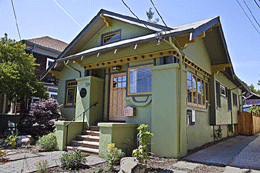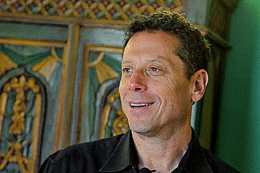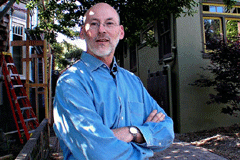The Greenest House
Air Date: Week of July 10, 2009

A platinum-green home. (Photo: Lonny Shavelson)
David Gottfried believes that green is beautiful and he has renovated his house to prove it. His 1915 Craftsman home in Berkeley, California is so energy efficient that it has received the highest U.S. building rating for a reconstructed building - a platinum LEED certification. Reporter Lonny Shavelson went to visit this environmental Eden to see if there are eco-lessons for the average homeowner.
Transcript
YOUNG: The U.S. Green Building Council administers a program to rate the environmental impact of buildings. It’s known as Leadership in Energy and Environmental Design, or LEED for short. The top LEED rating is platinum.
And in Berkeley, California, David Gottfried says his craftsman styled bungalow has garnered more points over platinum than any other house in the United States. Lonny Shavelson took a look.

David Gottfried, eco-perfectionist. (Photo: Lonny Shavelson)
GOTTFRIED: You know, there are straw bale homes, there are earth ship homes. And I think in some ways they would beat me on ecological impact.
SHAVELSON: But competing in an eco-battle with straw bale houses isn’t Gottfried’s point. A lean middle-aged man in a baggy sweater, he looks more like an ivy-league English Lit professor than an enviro-radical. He says his goal is to show that you can be hyper-green living in any house – in his case, an old renovated craftsman home in a mixed residential commercial zone on the border of Berkeley and Oakland.
GOTTFRIED: The way to really green the homes of the world is to green what we have, the existing stock. You want to have something that the market understands. So we wanted to showcase how to make an existing home not just deep green, but gorgeous.
SHAVELSON: And that’s where some might say David Gottfried went over the environmental cliff. This is a man who read the novel Siddhartha, about the search for that spiritual perfection called nirvana, eighteen times. So when Gottfried got down to eco-perfecting that old craftsman house…
GOTTFRIED: We did solar electric, and solar hot water, and rain water capture, and gray water capture, and all the windows and all the utilities and insulation. We got salvaged wood from the old Sacramento main bridge. We had radiant water and it supplies the hot water as well as our heating. We put 2.7 kilowatts of solar on the house, about 16 panels.

This electric meter runs backwards. (Photo: Lonny Shavelson)
GOTTFRIED: And I’m trying to get my girls to only pee in that toilet.
SHAVELSON: Anybody else out there, like me, living in a decidedly on-the-grid energy hog of an old comfy house – who listens to Gottfried’s green house mantra and says, oof, I can’t do all that stuff. Even Gottfried admits:
GOTTFRIED: I do think in hindsight that we went overboard on the house. Maybe more than a little. My green passion poured out in a flood.
SHAVELSON: Which did get Gottfried the highest green score of any house certified in the U.S. But for the rest of us, keeping up with the Gottfrieds seems impossible. So to learn from his home what we can reasonably do with our own, I asked architect Henry Siegel to come with me on a tour of Gottfried’s house. He’s certified in environmental architecture by the U.S. Green Building Council.
[SOUNDS OF PEOPLE GREETING EACH OTHER]
Siegel barely glances at the rain hogs, solar panels, gray water irrigation system – tens-of- thousands of dollars of Gottfried’s fancy eco innovations. Then he asks Gottfried about the simplest and cheapest changes he’s made…
SIEGEL: I’m really curious to know more about what you did in terms of air sealing and insulation and all those envelope improvements that are really cheap, but really pay off fast. Because that’s the kind of thing that’s really transferable, really quickly, that anybody can do.

Henry Siegel is certified in environmental architecture. (Photo: Lonny Shavelson)
GOTTFRIED: They put an air blower on a door so they can track the air loss. And then they run around with caulk and weather stripping and foam, and tighten it up. And in that day we tightened it up by 50%. And it was $600. It tightened it up more than brand new windows, which could be $30,000. So if we just ran around the U.S. doing that.
SIEGEL: It would save an enormous amount of energy.
SHAVELSON: Siegel agrees that eco simplicity is the real eco sexy.
SIEGEL: It only costs four, five hundred dollars to get the guys to come in with infrared cameras and do all the testing to tell you exactly where your worst leaks are and to fix them. And that’s the really fast payback.
GOTTFRIED: And also create the green collar jobs, because it’s low tech.
SHAVELSON: Low tech? You’d think the two connoisseurs of green would get together and talk up a solar storm of techno-eco-babble. Surprisingly, their main message is – don’t sweat the big stuff; take care of the basics. I tell them I’m thinking of putting solar on my old, leaky home. Their faces don’t exactly light up with the idea.
GOTTFRIED: So many folks just want to slap solar on their inefficient homes, and that's really, as we know, the last thing -- even though it's the coolest thing, perhaps.
SHAVELSON: And, says Gottfried, the most ecologically crucial part of his house, isn’t in or on the building. It’s where it’s located.
GOTTFRIED: We’re flat, walkable, six homes from a grocery store and half a mile from the BART. But we were in the Berkeley Hills, and I didn’t REALLY want to green that home because it wasn’t walkable. What’s interesting here since we moved is how little I drive.
SHAVELSON: Gottfried says that if you start at the basics and then climb up to green nirvana on a ladder of ecological gadgetry as he did– each step higher costs more and yields less. And, says architect Siegel, all that green stuff loaded on a house can look pretty funky. What he really liked about Gottfried’s eco-elegant but architecturally straightforward home was…
SIEGEL: This looks like a craftsman house, it doesn’t look like it’s trying to be something other than it is. The sign of maturity is that people realize that green is not a style, that it really can fit with any style of architecture and make it more comfortable and more efficient.

The house where the Gottfrieds live rates platinum on the LEED building scale. (Photo: Lonny Shavelson)
GOTTFRIED: I have to go further. Today I met with a fuel cell company that has personal home fuel cells.
SHAVELSON: So while Gottfried continues his ascent to an environmental heaven – the rest of us might do almost as well with our feet still firmly on earth. For Living on Earth, I’m Lonny Shavelson in Berkeley, California.
Living on Earth wants to hear from you!
Living on Earth
62 Calef Highway, Suite 212
Lee, NH 03861
Telephone: 617-287-4121
E-mail: comments@loe.org
Newsletter [Click here]
Donate to Living on Earth!
Living on Earth is an independent media program and relies entirely on contributions from listeners and institutions supporting public service. Please donate now to preserve an independent environmental voice.
NewsletterLiving on Earth offers a weekly delivery of the show's rundown to your mailbox. Sign up for our newsletter today!
 Sailors For The Sea: Be the change you want to sea.
Sailors For The Sea: Be the change you want to sea.
 The Grantham Foundation for the Protection of the Environment: Committed to protecting and improving the health of the global environment.
The Grantham Foundation for the Protection of the Environment: Committed to protecting and improving the health of the global environment.
 Contribute to Living on Earth and receive, as our gift to you, an archival print of one of Mark Seth Lender's extraordinary wildlife photographs. Follow the link to see Mark's current collection of photographs.
Contribute to Living on Earth and receive, as our gift to you, an archival print of one of Mark Seth Lender's extraordinary wildlife photographs. Follow the link to see Mark's current collection of photographs.
 Buy a signed copy of Mark Seth Lender's book Smeagull the Seagull & support Living on Earth
Buy a signed copy of Mark Seth Lender's book Smeagull the Seagull & support Living on Earth

